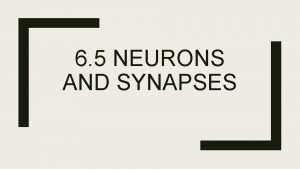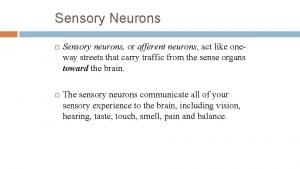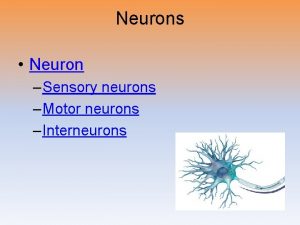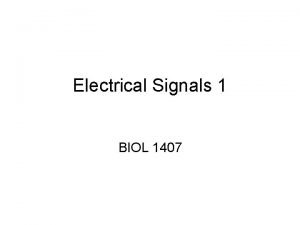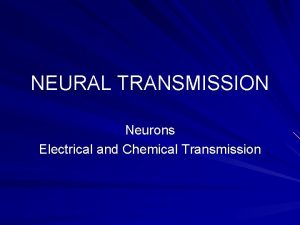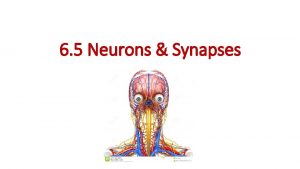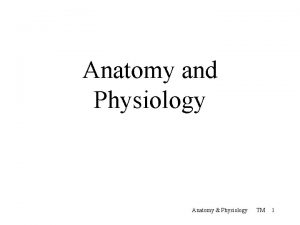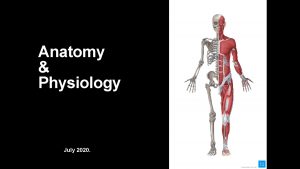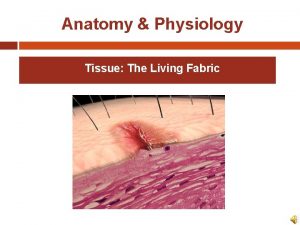Anatomy and Physiology I Electrical Signals in Neurons




























- Slides: 28

Anatomy and Physiology I Electrical Signals in Neurons Action Potentials The Synapse Instructor: Mary Holman

Electrical Signals in Neurons • Two basic features of cell membranes of neurons and other excitable cells Membrane potential Ion channels • Allow neurons to communicate using electrical signals Action potentials

Fig. 10. 14 c The Membrane Potential of the Resting Neuron Trigger Zone High Na+ + – + – Low Na+ Impermeant + Na+ anions – Pump + K – + + High K – Low K+ – + + – – + – 70 m. V Membrane Potential = unequal distribution of + and - ions on either side of a cell membrane -70 millivolts 1 m. V= 0. 001 Volts

Resting Membrane Potential of the Neuron From: Principles of Anatomy & Physiology by Tortora & Grabowski

Ion Channels Gated channels that open and close in response to a stimulus 1. Voltage-gated ion channels as in action potentials 2. Ligand-gated ion channels as in neurotransmitters 3. Mechanically-gated ion channel

Fig. 10. 13 Gate-like Mechanism of Ion Channels Stimulus -action potential -chemical -mechanical (a) Channel closed (b) Channel open ions Cell membrane Fatty acid tail Phosphate head Protein Membrane potential changes due to movement of ions when channels are open Copyright © The Mc. Graw-Hill Companies, Inc. Permission required for reproduction or display.

Membrane Polarization • A cell that has a membrane potential is said to be polarized • When the ion flow due to the opening of an ion channel produces a more negative membrane potential it is called hyperpolarized • If the membrane potential becomes more positive, it is called depolarized

Action Potential • If the membrane is depolarized to ~ -55 m. V it is said to have reached threshold potential • When a threshold potential is reached, a nerve impulse or action potential is generated

Fig. 10. 15 a Sub-threshold Depolarization Does not Result in an Action Potential Trigger Zone Na+ Neurotransmitter Na+ – 62 m. V Ligand-gated Na+ channel Presynaptic neuron Copyright © The Mc. Graw-Hill Companies, Inc. Permission required for reproduction or display.

Fig. 10. 15 b An Action Potential is Generated When Depolarization Reaches ~55 m. V Voltage-gated Na+ channel Trigger zone Na+ Na+ Ligand-gated Na+ channel Na+ – 55 m. V Copyright © The Mc. Graw-Hill Companies, Inc. Permission required for reproduction or display.

Fig. 10. 16 Na+ Na+ Na+ K+ K+ K+ K+ Na+ Na+ – 0 – 70 Na+ Na+ Na+ Na+ (a) K+ Na+ K+ Threshold stimulus K+ K+ Na+ K+ K+ K+ – 0 K+ Action Potential & Nerve Membrane Na+ channels open K+ channels closed K+ Na+ – 70 Na+ Na+ Na+ Na+ Region of depolarization (b) K+ K+ Na+ Na+ Na+ K+ K+ K+ K+ Na+ Region of repolarization Na+ Na+ Na+ – 0 – 70 Na+ K+ channels open Na+ channels closed

An Action Potential = Nerve Impulse • All-or-none response all impulses are the same strength more stimuli leads to more impulses • Refractory Period Absolute vs Relative period of time between impulses when membrane is unresponsive to stimuli ~1 --30 milliseconds

Fig. 10. 17 Oscilloscope Recording of an Action Potential Membrane potential (millivolts) +40 Action potential +20 0 – 20 Resting potential reestablished – 40 Resting potential – 60 – 80 Hyperpolarization 0 1 2 3 4 5 Milliseconds 6 7 8 Copyright © The Mc. Graw-Hill Companies, Inc. Permission required for reproduction or display.

Fig. 10. 18 A Nerve Impulse = moving Zone of Depolarization Region of action potential + + + – – – – – + + + + + – – – + + + – – – + Direction of nerve impulse – – – + + + + – – – – + + – – – + + + + – + + Copyright © The Mc. Graw-Hill Companies, Inc. Permission required for reproduction or display.

Impulse Conduction • Myelinated nerves conduct action potentials from node to node • This mode of transmission is called saltatory conduction

Fig. 10. 19 A Nerve Impulse Moving along a Myelinated Axon Action potential +++ Nodes Electric current ++ –– –– ++ (a) ++ –– –– ++ Axon ++ –– –– ++ ++ –– –– ++ Schwann cells Action potential ++ –– –– ++ +++ (b) ++ –– –– ++ Action potential ++ –– –– ++ +++ Copyright © The Mc. Graw-Hill Companies, Inc. Permission required for reproduction or display.

The Synapse • Nerve impulses pass from neuron to neuron at synapses, moving from a pre-synaptic neuron to a post-synaptic neuron. • Neurotransmitters are released when the impulse reaches a synaptic knob

Fig. 10. 11 Synapses of Three Neurons Synaptic cleft Impulse Dendrites Axon of presynaptic neuron Axon of postsynaptic neuron Axon of presynaptic neuron Impulse Cell body of postsynaptic neuron Impulse Copyright © The Mc. Graw-Hill Companies, Inc. Permission required for reproduction or display.

Events at the Synaptic Cleft • Action potential races along axon to the terminal knobs or varicosities. • The change in polarization of the membrane of the knob opens voltage sensitive Ca++ gates & Ca++ floods in. • The increased [Ca++] stimulates vesicles to move to the cell membrane and release neurotransmitters via exocytosis. • Neurotransmitter molecules bind to receptors on postsynaptic neuron membrane which opens ligand-gated ion channels. Depending on which ion channels are opened, membrane is hyperpolarized or depolarized.

Fig. 10. 12 a Direction of nerve impulse Synaptic vesicles Axon Ca+2 Synaptic knob Activity at a Synaptic Cleft Presynaptic neuron Ca+2 Cell body or dendrite of postsynaptic neuron Mitochondrion Ca+2 Synaptic vesicle Neurotransmitter Vesicle releasing neurotransmitter Axon membrane Synaptic cleft Polarized membrane Copyright © The Mc. Graw-Hill Companies, Inc. Permission required for reproduction or display. Depolarized membrane

Fig. 10. 12 b A Synaptic Cleft Mitochondrion Synaptic vesicle TEM 37, 500 x Synaptic cleft Postsynaptic membrane © Don W. Fawcett/Photo Researchers, Inc. Copyright © The Mc. Graw-Hill Companies, Inc. Permission required for reproduction or display.

Neurotransmitters • Released from vesicles in terminal knobs of presynaptic axons • React with receptors on membrane of postsynaptic neuron • Many different molecules act as neuro- transmitters • Many serious diseases result from imbalances of neurotransmitters

Actions of Neurotransmitters • Can cause excitatory (EPSP) or inhibitory (IPSP) post-synaptic membrane potentials by opening or closing various ion channels • Usually the net effect the EPSPs and IPSPs is determined in the region of the trigger zone of the neuron

Fig. 10. 20 Neurons Receive Multiple Signals Simultaneously Neuron cell body Nucleus Presynaptic knob Presynaptic axon Copyright © The Mc. Graw-Hill Companies, Inc. Permission required for reproduction or display.

Impulse Processing • Neuron pools in CNS interpret impulses from many neurons • Convergence Multiple axons delivering impulses to the same neuron • Divergence An axon that branches and delivers impulses to several neurons

Fig. 10. 21 a Impulse Convergence 1 2 3 Copyright © The Mc. Graw-Hill Companies, Inc. Permission required for reproduction or display.

Fig. 10. 21 b Impulse Divergence 4 6 5 Copyright © The Mc. Graw-Hill Companies, Inc. Permission required for reproduction or display.

Fig. 10 A Addictions Ion channel Outside nerve cell Nicotine Membrane lipid bilayer • Some addicting compounds bind to sites that bind intrinsic pain relievers (endorphins) • Others alter binding of neurotransmitters acting either as an agonist or antagonist Inside nerve cell Copyright © The Mc. Graw-Hill Companies, Inc. Permission required for reproduction or display.
 Animals and human language chapter 2
Animals and human language chapter 2 Language
Language Communicative signals and informative signals
Communicative signals and informative signals Inspiration anatomy and physiology
Inspiration anatomy and physiology Tattoo anatomy and physiology
Tattoo anatomy and physiology Anatomy science olympiad
Anatomy science olympiad Imperfect flowers examples
Imperfect flowers examples Anatomy and physiology bones
Anatomy and physiology bones Peptic ulcer anatomy and physiology
Peptic ulcer anatomy and physiology Liver anatomy
Liver anatomy Epigastric region
Epigastric region Epigastric region
Epigastric region Anatomy and physiology blood
Anatomy and physiology blood The central sulcus divides which two lobes? (figure 14-13)
The central sulcus divides which two lobes? (figure 14-13) Human anatomy and physiology seventh edition marieb
Human anatomy and physiology seventh edition marieb Http://anatomy and physiology
Http://anatomy and physiology Chapter 1 introduction to human anatomy and physiology
Chapter 1 introduction to human anatomy and physiology Appendix anatomy and physiology
Appendix anatomy and physiology Aohs foundations of anatomy and physiology 1
Aohs foundations of anatomy and physiology 1 Aohs foundations of anatomy and physiology 1
Aohs foundations of anatomy and physiology 1 Anatomy and physiology of swine
Anatomy and physiology of swine Anatomy and physiology chapter 8 special senses
Anatomy and physiology chapter 8 special senses Chapter 13 anatomy and physiology of pregnancy
Chapter 13 anatomy and physiology of pregnancy Teks anatomy and physiology
Teks anatomy and physiology Science olympiad forensics cheat sheet
Science olympiad forensics cheat sheet Chapter 2 basic chemistry anatomy and physiology
Chapter 2 basic chemistry anatomy and physiology Physiology of stomach ppt
Physiology of stomach ppt Anatomy and physiology diabetes
Anatomy and physiology diabetes Anatomy and physiology chapter 7
Anatomy and physiology chapter 7





























